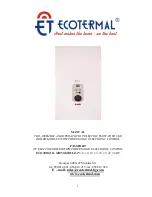
4
Set-up and installation
Installation and operating instructions
20
Daikin/ROTEX A2 F
Oil condensing boiler A2 F
008.1546499_02 – 04/2018 – EN
INFORMATION
There must not be any hydraulic blocking elements
between the heat generator and the diaphragm expansion
vessel that can be operated by the system operator. The
location (
Fig. 3-3
and
Fig. 3-4
, item 25) provided for the
connection of an integrated diaphragm expansion vessel
(accessory) is not closed when delivered. If the diaphragm
expansion vessel is connected outside the heat generator,
this point must be sealed on site.
1
Carefully insulate pipework against heat loss and to avoid con-
densation (insulation thickness at least 20 mm).
–
Water shortage protection
: The pressure and temperature
monitoring of the A2 F switches off the oil condensing boiler
safely in the event of a lack of water and locks it. No addi-
tional water shortage protection is needed in the construc-
tion.
–
Avoid damage caused by deposits and corrosion:
Ob-
serve the requirements on the heating water (see
Chap.
1.2.5
).
4.6.2
Connect the condensate drain
The condensate resulting from the cooling of the combustion gases
in the boiler and in the flue gas system has a pH-value of 1.8 – 3.7. If
necessary, it must be neutralised in accordance with the guidelines
of the German Wastewater Association (DWA A251) before being
discharged into the public sewage system.
INFORMATION
Depending on the stipulations of the community waster wa-
ter regulations, the neutralisation can be dispensed with, if
the condensing boiler is operated
exclusively
with
EL
low-sulphur heating oil
.
The condensate is conducted via the condensate siphon mounted
on the flue gas elbow under the boiler body and then discharged into
the sewage system.
If the condensate has to be neutralised before discharge into the
sewage system, a condensate box (accessory) can be installed in
the boiler instead of the condensate siphon.
Fig. 4-9
Connection of the condensate drain line
The condensate box can be mounted under the boiler frame and
connected to the flue gas connection piece of the boiler. The con-
nection to the wastewater network is designed for
HT pipe DN 50
.
1
Condensation drain line (not included) with free inflow to the
drains connection.
2
Lay the condensate drain sloping down from the boiler, so that
condensation will not accumulate in the flue gas pipe.
INFORMATION
If it is not possible to connect the condensate drain to the
waste water system with a sufficient gradient in the install-
ation room, a condensate lifting pump must be installed on
site.
3
The complete outlet must not be lockable and must discharge
the condensation and any medium leaking due to damage (heat-
ing water) outwards visibly (e.g. hose to flow drain or transparent
outlet pipe).
4
In order to avoid accumulation in the flue gas connection of the
boiler, make sure that no additional siphon is formed from the
condensate drain line to the connection to the wastewater line.
5
Fill the condensate siphon or condensate box. To do so, pour in
water via the inspection opening of the flue gas pipe.
6
Check the condensate drain section for leakage.
4.7
Electrical connection
DANGER: RISK OF ELECTROCUTION
Touching live parts can result in an
electric shock
and
lead to potentially fatal injuries and burns.
▪
Before
beginning work on live parts, disconnect all of
the systems circuits from the power supply (switch off
external main switch, disconnect fuse) and secure
against unintentional restart.
▪ Establishment of the electrical connection and work on
electrical components should only be performed by
elec-
trical technicians
in compliance with valid standards
and guidelines as well as the specifications of the en-
ergy supply company and the instructions in this manual.
▪ Never make constructional changes to connectors or
other electrical equipment components.
▪
Device covers and service panels
must be
replaced
as soon as the work is completed.
All A2 F control and safety devices are connected ready for use and
tested. Modifications on the electrical installation are dangerous and
prohibited. The operator alone shall bear responsibility for any result-
ing damage.
Mains connection, external temperature sensor and other optional
applications must still be connected to the boiler control panel.
4.7.1
Opening the boiler control panel and
establishing electrical connections
1
Check the supply voltage
(~230 V, 50 Hz
).
2
Set the mains switch of the A2 F to "Off" (see
Fig. 3-2
, item 7).
3
Switch off the circuit breaker in the junction box of the domestic
power supply.
4
Remove the front panel of the boiler control panel (
Fig. 4-10
).
















































